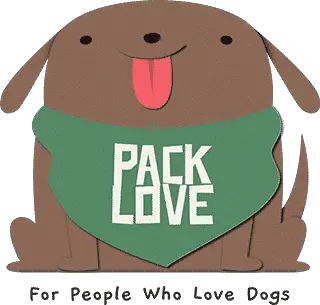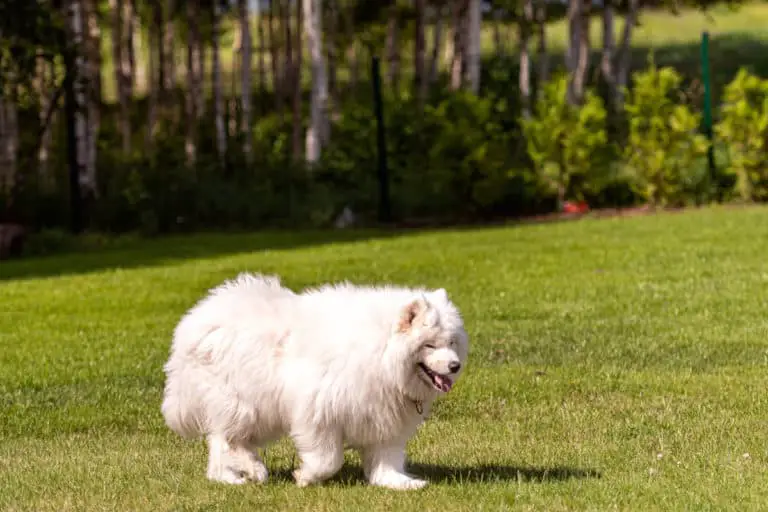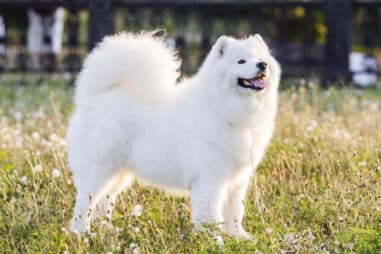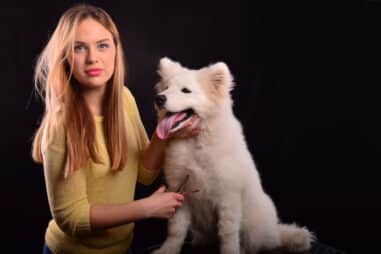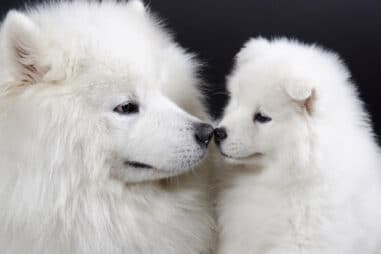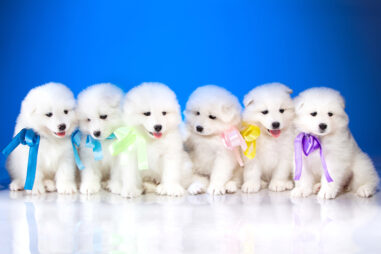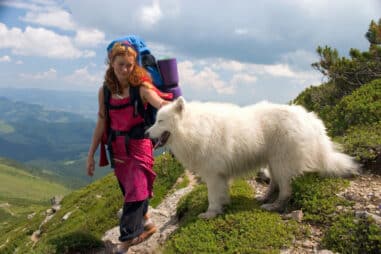Samoyeds have thick fur, but how many layers do they have? Twelve to thirteen layers, according to some individuals. Others argue that there is only one layer. But the truth is that there are three layers of fur.
A Samoyed can have a shiny, straight coat or a softer, more wooly undercoat. The softest of canine coats can be seen in dogs that came from regions with colder climates. But, the roughest fur is typically seen on Samoyeds living in warmer areas.
Samoyed’s have different colors of fur, too. They can be white, cream, biscuit, orange, or lemon. Sometimes they have a tinge of black hair on their head and black patches around their eyes too.
Find out more about the Samoyed coat as we get deeper into the subject.
Do Samoyed Dogs Have Fur or Hair?
This is a very common question among dog owners, and the answer to this is that Samoyed dogs have fur. But naturally many people tend to describe their dog as having “hair”.
People tend to use the word “hair” to mean any kind of animal fiber. It is a misnomer. This leads to confusion and it makes some people think that the breed only has hair and not fur.
The way to tell the difference between Samoyed fur and hair is to observe how it grows from their skin. If you see a Samoyed dog up close, you will notice that their coat is made up of coarse, straight hairs.
They are somewhat similar in appearance to human black or brown hair. But, unlike human hair, the Samoyed fur does not grow down to cover their skin.
Samoyed fur is also made of two layers. The outer layer, which you see when the dog sheds its winter coat, is called the “guard hair” layer. This outermost layer is made up of tough, coarse hairs. These hairs protect your pet from severe weather conditions like extreme cold.
The bottom layer is called the “undercoat”. Undercoats provide the insulation needed to keep these dogs warm during the winter months. But they remain cool and comfy in muggy summer afternoons.
How Many Layers of Fur Does a Samoyed Have?
The Samoyed has a lot of fur, but how many layers? Some people might think there are twelve, or thirteen layers. Others might say there’s only one layer of fur. However, the real answer is that they have three layers of fur.
The topmost layer is called the “overcoat” and it consists of long straight guard hairs. This layer is usually what people see and touch, and the Samoyed will shed this layer in large clumps twice a year.
The undercoat layer is thick and fluffy; this is what keeps the Samoyed warm during really cold weather. Some breeds shed their undercoats as well, but not like the overcoat. The Samoyed does not shed its undercoat.
The third layer is made up of a unique type of fur that is finer than the other two layers, but just as warm. This layer acts like Velcro and naturally clings to the hair in the overcoat.
All three layers protect the Samoyed from harsh weather conditions including snow, water, and sand. They give the Samoyed its characteristic look and also help it to retain body heat.
When this breed is playing outside in the snow, you will see that they do not get cold because their warm fur keeps them nice and toasty!
What Type of Coat Does a Samoyed Have?
The Samoyed is a breed of dog known for its thick, white coat that is best described as something like wool. If you’ve ever felt this type of coat yourself, then you have a good idea how really soft it is. This unique look adds to the overall beauty of the Samoyed. However, there are some important things to keep in mind when it comes to this type of fur.
Samoyed dogs come in a variety of colors and patterns, but all boast the classic thick white coat that is signature to the Samoyed breed. This dense undercoat and outer coat make for an extremely heavy shedding process. This means it’s important to keep up with grooming your Samoyed. Otherwise, you could find yourself with a home that looks like it’s been through a blizzard!
Do Samoyeds Have Double Coats?
The short answer is yes. A double coat is when a dog has two layers to its coat, an undercoat, and a topcoat. The Samoyed’s topcoat is straight and harsh with no curl in it.
The Samoyeds shed their coat, but the amount of hair they lose during their molting period varies from one year to another. This depends on how quickly their undercoat comes out.
The undercoat of Samoyed dogs only grows during certain months of the year. After these dogs have more than one heat cycle, they will typically grow a double coat every year rather than just an undercoat once a year or less.
Samoyed’s are sled dogs that were bred in Siberia to work in very cold conditions, which requires a heavy undercoat to keep them warm. These dogs have been bred by humans for a very long time. It is thought that the type of coat they originally had has changed through the years since they were first bred.
The climate plays a significant role in how long the individual hairs in a Samoyed’s coat will grow. If it is cold enough, their bodies tend to produce a heavy coat; if it is warm out, their bodies will shed instead. Although the shedding process is sometimes very heavy or intense.
Do Samoyeds Have Undercoats?
A Samoyed does have an undercoat for warmth. But their undercoats are not like most other dog breeds. Instead, they are made up of extremely thick fur that traps air and provides excellent insulation. Samoyeds also have guard hairs that help protect this undercoat.
A Samoyed’s undercoat is its most unique feature. Most breeds have a soft top layer and a bottom layer that is dense to provide insulation from the cold. The Samoyed has an additional middle layer of fur – its undercoat – which insulates their bodies even more efficiently.
Many people think that the Samoyed’s undercoat is the only layer in their coat and they only shed it when it falls out. But this is not true. In fact, most of a Samoyed’s coat stays in their bodies and they will lose parts of it at various times throughout the year. This usually takes place when they rub or scratch against surfaces. This makes regular grooming for Samoyed dogs a must in order to avoid excessive hair loss.
Do Samoyeds Have Soft Fur?
Samoyeds have a double coat that is fluffy and soft. They even grow softer as they mature through the years. This usually occurs around the age of 4 months old for most Samoyeds. Soft Samoyed fur is brought about by the presence of undercoats and guard hairs.
The undercoat of this particular canine group consists of very fine, fluffy hair. As for their guard hairs, they are incredibly straight and stiff. These two layers in the Samoyed’s coat work hand in hand to form a very effective protective waterproof barrier on the surface of the dog’s skin. They help in keeping the snow and rain from getting through and wetting or chilling the dog’s skin, which is kind of sensitive.
Besides, guard hairs are very helpful in keeping foreign matter from reaching or even touching the undercoat and skin. The guard hairs also assist in preventing water from getting into the hair.
Are Samoyeds Fluffy?
The short answer is: sometimes, but it depends on the Samoyed. In general, Samoyeds are considered fluffy dogs. They usually come in thick fur which can range from straight and smooth to corkscrew curls.
But not all Samoyeds have a lot of fur. Certain varieties of this breed have been developed to be more sparsely furred. Sometimes they are even hairless. Therefore, the fluffiness of their coat will depend on their pedigree. These dogs often have far less fur than a standard Samoyed. For instance, they only have little patches of hair on their feet and snout.
Sparsely furred dogs may not be as adorable or fluffy as the breed standard. But they may prove to be a better alternative for people who, to a certain extent, are allergic to dogs.
Are All Samoyeds Fluffy?
The answer is, of course, a resounding “No!” Some Samoyeds have a single coat which means they do not have a soft layer beneath. Others may have a double coat with a softer undercoat. This does not mean that just because the dog has thinner fur it will be less fluffy. When they curl up they can still resemble a small polar bear.
The variation between each dog’s fur may have something to do with genetics, with some dogs able to grow more fur than others. Their daily diet will also have a significant impact on this. So much so that a dog with a healthy, balanced diet every day is likely to have thicker, fuller fur than one who is not.
Samoyeds are a lovely breed of dog noted for being fluffy fur babies, although we can’t expect every single one to come in thick and abundant fur. But they are, nonetheless, maybe just as lovely!
Why Is My Samoyed Not Fluffy?
If a Samoyed does not seem to have a fluffy coat, consider the age of your pet. It is possible that your dog has not reached his age of maturity. Hence, the fluffiness of his coat may still be a work in progress. The fluffiness of a Samoyed will continue to develop once the dog has reached adulthood.
But sometimes even adult Samoyeds are not always fluffy. Some of the possible underlying reasons could be grooming or genetics. Or it can be a combination of the two.
If your Samoyed dog is not very fluffy as an adult, daily brushing should help. But take note that results could vary. Noticeable improvements should be visible from a couple of weeks to several months.
In general, Samoyeds have a fluffy coat, but some adults don’t seem to show the expected level of fluffiness for their breed. Grooming is a vital part of maintaining a Samoyed’s coat and its fluffiness. If you only occasionally brush your Samoyed, then it may be fluffier if you will do so regularly.
Do Samoyeds Lose Their Hair?
Since they have thick winter coats, Samoyeds are sometimes referred to as “snow dogs.” Some Samoyed owners find it shocking to see that their dog’s fur comes off every year, losing it sometimes in large clumps.
The annual loss of coat that we see in Samoyeds and other long-haired breeds is natural. There is no reason for alarm when this happens, but it may appear weird the first time you see them lose it. The good news is that their fur will grow back to its natural state.
Samoyed dogs have a double coat, with an oily topcoat, guard hair, and a thick undercoat. In their native Siberia, these three layers in their coat keep them warm in the winter months when temperatures drop below zero. In the hotter months of the year, Samoyeds may get overheated while they are playing outside.
During molting season, they can be seen rasping away dead hair with their teeth. And there is no reason for alarm if you see them lose small amounts of hair throughout the year.
The undercoat may fall out in large chunks or mats, but this will grow back after shedding season is over. If the undercoat is not shed properly, it may become matted in thick clumps that are difficult to remove. Brushing will help distribute the natural oils in their fur, minimizing the likelihood of getting tangled or matted. So make sure you get into that habit if you own a Samoyed.
Can You Use Samoyed Hair?
You may have a genuine love for your Samoyed dog, but there is one drawback to having one — their loose fur. Otherwise known as molting, their loose fur can get onto clothes and furniture. It is a sight that can get anyone annoyed when they are in lumps.
Here are some practical ways that other Samoyed owners use their dog’s loose fur:
Knit Your Samoyed’s Fur
In the same way that wool can be spun and knit, dog hair can be spun and knit. Having items that are woven from your dog’s fur, from gloves to sweaters, is a special keepsake. Nevertheless, not every dog hair can be spun into “chiengora,” which is the official name for dog fur wool.
Canines with long hair and soft coats have fur ideal for spinning, owing to their undercoat. The longer the undercoat, the better it spins. Dogs with short undercoats can have their fur made into wool by blending it with a longer fiber, such as alpaca or sheep wool.
Make Felted Materials
Felting is the traditional way of transforming wool cloth into a dense material that does not unravel. These materials are used to make clothes, soft sculptures, and even stuffed animals!
The process is simple. Warm water and soap are mixed to create soapy water. The wool cloth will need to be placed within the mixture for a period of time, which will vary depending on the desired size of your material. Then, you can use scissors or hands to shape it into whatever form you want! Let the material dry and it will become stiff and sturdy. It will be warm and soft to the touch and ready for use!
Protect Your Garden
Samoyed dogs enjoy chasing animals out of the yard, and the fragrance of their fur may keep pests at bay. Hence, in a way, it acts like it is a pest deterrent. You may wrap your yard in burlap bags or pantyhose, but first, stuff it with your Sammie’s fur. Consider putting a border around your garden fence’s perimeter to camouflage it even further.
Soil Fertilizer
Pet fur is super rich in nitrogen. It is a crucial component for plant growth. Thus, it stands to reason that you can take advantage of it to nourish your garden soil. It promotes moisture retention in the ground and the regulating of plant temperature. Over time, the hair will disintegrate and thus release nitrogen into the soil, enriching it.
Stuff Pillows
Dog fur does an amazing job as a stuffing material. If you’re handy with a sewing machine, you can create your homemade dog toys for your Samoyed out of his fur rather than synthetic stuffing. Take into account sewing a dog bed for an easier project, or if you want to enjoy the comfort of fur yourself, make a throw pillow for your sofa.
What Is Samoyed Yarn?
Samoyed yarn is a breed-specific yarn. It intends to replicate as closely as possible the fluffy coat of a Samoyed dog. Along with being flattering, you can use it for a variety of crafts. Thus providing a unique element to your finished product.
For years, people have been making yarn that looks like the fluffy coat of a Samoyed dog. It wasn’t until recently that breed-specific yarns were used in the production of select handicrafts.
Samoyed yarn can be used in creating amigurumi ornaments, plush animals, and even as an accent material in some apparel designs. You can also use them in creating custom trinkets such as bracelets or any other similar personal bling.
Can You Knit With Samoyed Fur?
You certainly can! Whatever you want to knit from Samoyed fur is a matter of personal choice. This can be decided by learning about the benefits and drawbacks when knitting using this type of material.
Samoyed fur comes from the Samoyed dog breed. Hence, the name. It is said that these dogs are among the friendliest in the canine universe. They are also among the most docile breeds out there because they were bred as human companions. This means that if you like to cuddle, Samoyed fur might be right up your alley. If not, well … it’s just dog hair.
A Samoyed’s fur can maintain its softness even when knitted into handicraft projects. It is one of its many amazing attributes.
Samoyed dogs are white or cream colored so their fur will be either of this color or a mix of lighter colors. If they were exposed to the elements, the ends of an animal’s hair tend to become darker. If the Samoyed fur is dyed, it will be so even that you won’t notice any pattern; dyeing makes Samoyed fur very consistent.
How Do You Turn Samoyed Fur Into Yarn?
Natural fibers are excellent for knitting because they are soft, manageable, and easy to handle. Besides, the resulting apparel is easy to wear.
There are ways to transform Samoyed fur into yarn that is wearable and can be used for all your different favorite projects!
- Before you get started, make sure you know what kind of fur you have.
- It will be much easier if you have an undercoat or “guard” rather than a top coat to work with! Topcoat fur is long and stiff, which makes it much harder to turn into yarn.
- It’s also best if you can find a friend to help you since you will need another set of hands along the way.
- The initial step, of course, is collecting your dog’s hair first.
- Most Samoyeds’ undercoats will come out on their own. But making it a habit to brush your dog’s coat regularly will ensure that you have plenty to work with.
- Once you have a good amount of fur, the next step is to wash it.
- It must be completely free of odors and clear of contaminants before you dye or spin it.
- Make sure that you do not use any products containing bleach or chemical-based detergents in washing the fur.
- There are lots of ways to dye your Samoyed fur, but a popular option is using Rit dye. It is relatively easy to use and comes in a wide variety of colors.
- After you’ve dyed your fur, allow it to air dry thoroughly.
- Samoyed fur is ready for yarn spinning after you dye it!
- If you don’t know how or aren’t comfortable dealing with wool, try producing your yarn in a variety of colors. It will make the process easier.
- Start by purchasing some wool roving and separating it so that each one is a single color.
- Then, you can take one strand at a time and fold it in half so that it forms a loop.
- Now, hold the loop in one hand so that the top side is facing forward.
- Put another hand through the loop and twist your dyed fur until you have about an inch or two of twisted fur.
- Once you have it in place, pull the loose hair under the fur bundle and regrab it with your thumb and fingers.
- Now, guide your fur back through the loop you created in step 6. Make sure to keep even tension on all sides.
- Continue this process until you have finished the desired amount of fur!
- Once you’re done twisting, tie the yarn off with a knot and trim any excess fur.
Congratulations, you now have your very own Samoyed fur yarn! This type of yarn is great for knitting scarves, gloves, hats, and many more. Make anything with it that will keep you warm on those cold winter days. Enjoy!
Can You Sell Samoyed Fur?
If you’re considering selling Samoyed fur in hopes of making a lot of money, then you should throw that idea out. It is not a good idea but here is what you can do instead:
The Samoyed is a beautiful, fluffy breed of dog. But, selling Samoyed fur is not going to get you an impressive amount of money. Now if that is your motivation here, it’s not going to get you places. It is not as lucrative as one may think. Most people in the U.S., who are not Samoyed breeders or owners, would simply not be interested in buying dog fur.
The only option that you have is to sell your Samoyed’s fur on Etsy with a price tag of $150 to $200 per ounce. This is sure to get you some buyers, but it can be difficult to get the price you want without offering a bulk discount.
If you are determined to make a profit off your Samoyed’s fur, then sell it in 5- to 6-ounce bundles at a discounted rate. This may not make you the most money, but it’s better than selling ounces for a lot of money … but no takers.
To recap, selling Samoyed fur is not a sensible move. It is because there are no buyers, and the demand for such goods is not as high as you believe. But if you still want to get rid of the Samoyed fur, then sell it in bulk at a discounted rate.
